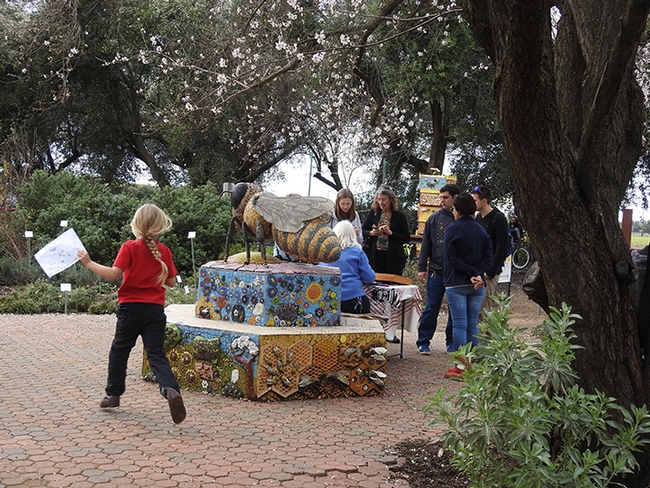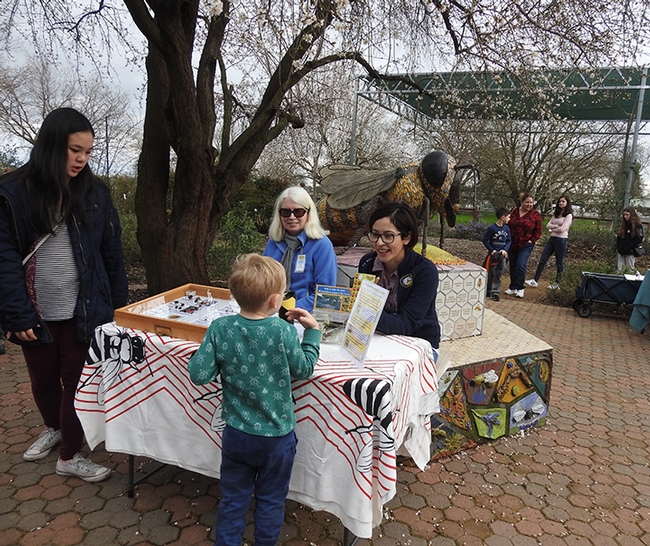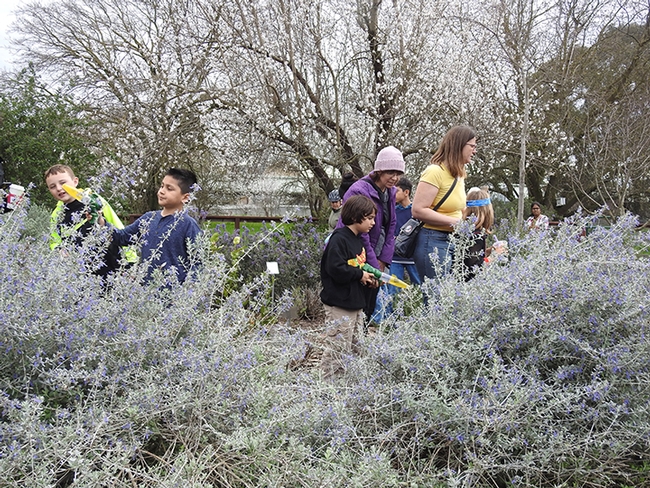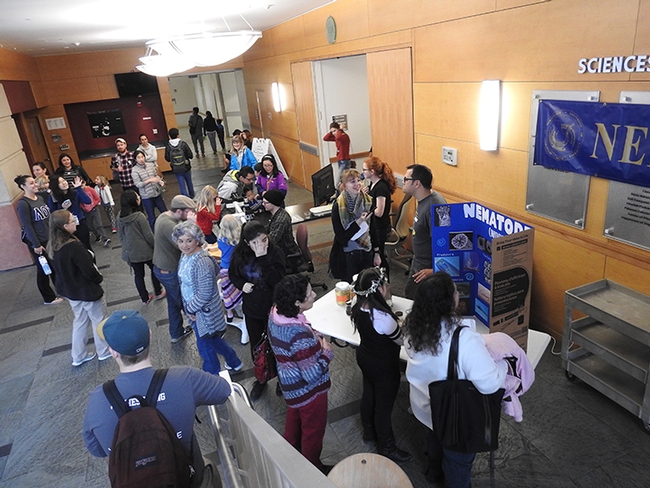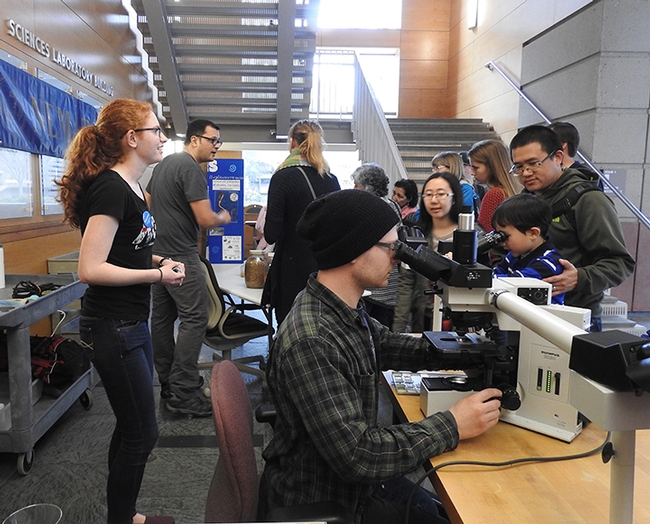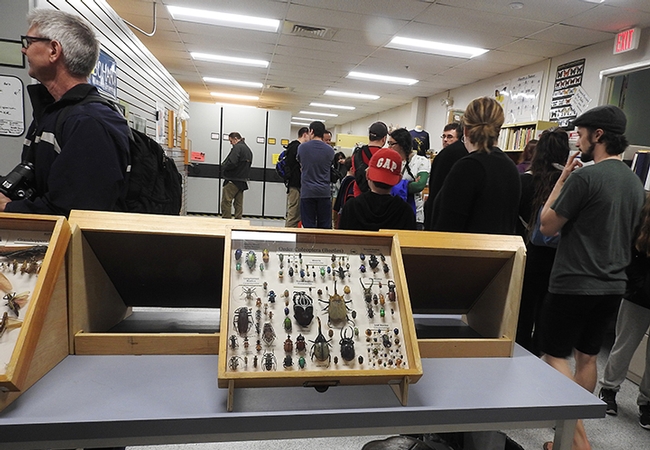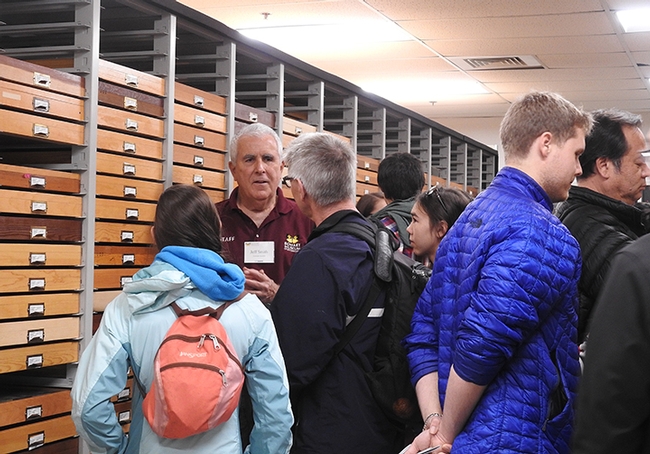- Author: Kathy Keatley Garvey
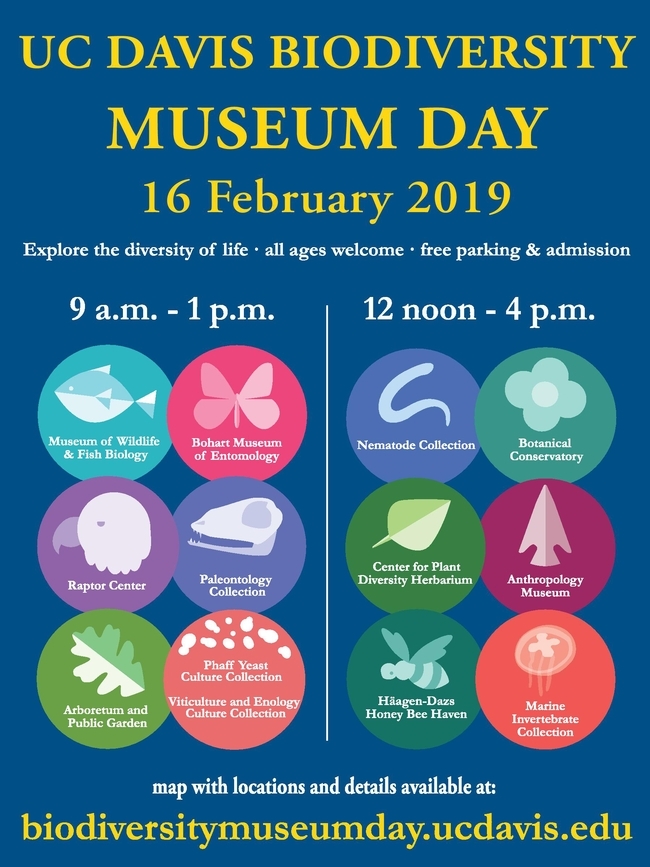
No? Ever watched scientists prepare a bobcat specimen for display? Or taken a selfie with a red-tailed hawk? Or petted a stick insect or a pine cone? How about kombucha tea--ever tasted it?
You can do that and more at the eighth annual UC Davis Biodiversity Museum Day, set from 9 a.m. to 4 p.m., Saturday, Feb. 16. The free, family friendly event will feature 13 museums or collections. All are within walking distance except for the Häagen-Dazs Honey Bee Haven on Bee Biology Road and the Raptor Center on Old Davis Road. The hours vary from 9 a.m. to 1 p.m. and from noon to 4 p.m.
The science-based event, exploring the diversity of life, drew more than 4000 visitors to the campus last year, according to Tabatha Yang, education and outreach coordinator for the Bohart Museum of Entomology.
New this year is the Marine Invertebrate Collection in the Sciences Laboratory Building, off Kleiber Hall Drive. “Visitors can expect to see specimens collected from Oahu and Baja California, and live corals,” said spokesperson Ivani Li. “There will be a touch tank. At some point there will be a brief presentation about squids where we will be showing off our Humboldt Squid or jumbo squid.”
The UC Davis Biodiversity Museum Day, always held the Saturday of Presidents' Day weekend, is billed as a “free, educational event for the community where visitors get to meet and talk with UC Davis scientists from undergraduate students to staff to emeritus professors and see amazing objects and organisms from the world around us.” Parking is also free. Maps are available on the Biodiversity Museum Day website at http://biodiversitymuseumday.ucdavis.edu/.
These seven collections will be open from 9 a.m. to 1 p.m.:
- Arboretum and Public Garden, Good Life Garden, next to the Robert Mondavi Institute, 392 Old Davis Road, on campus
- Bohart Museum of Entomology, Room 1124 of the Academic Surge Building, Crocker Lane
- California Raptor Center, 340 Equine Lane, off Old Davis Road
- Museum of Wildlife and Fish Biology, Room 1394, Academic Surge Building, Crocker Lane
- Paleontology Collection, Earth and Physical Sciences Building, 434 LaRue Road
- Phaff Yeast Culture Collection, Robert Mondavi Institute of Wine and Food Science, 392 Old Davis Road, on campus
- Viticulture and Enology Culture Collection, Robert Mondavi Institute of Wine and Food Science, 392 Old Davis Road, on campus
The following will be open from noon to 4 p.m.:
- Anthropology Museum, 328 Young Hall and grounds
- Botanical Conservatory, Greenhouses along Kleiber Hall Drive
- Center for Plant Diversity, Sciences Laboratory Building, off Kleiber Hall Drive
- Häagen-Dazs Honey Bee Haven, Bee Biology Road, off Hopkins Road (take West Hutchison Drive to Hopkins)
- Nematode Collection, Sciences Laboratory Building, off Kleiber Hall Drive
- Marine Invertebrate Collection, Sciences Laboratory Building, off Kleiber Hall Drive
All participating museums and collections have active education and outreach programs, Yang said, but the collections are not always accessible to the public. Maps, signs and guides will be available at all the collections, and also online at http://biodiversitymuseumday.edu, and on social media, including Facebook and Twitter, @BioDivDay.
Capsule information on each:
Arboretum and Public Garden
The Arboretum and Public Garden will present “investigation stations” from 9 a.m. to 1 p.m. at the Good Life Garden, next to the Robert Mondavi Institute, 392 Old Davis Road, on campus. Visitors will learn about the importance of bees, hummingbirds and moths as pollinators. They can play fun games, and color and craft their own pollinator pets.
Bohart Museum of Entomology
The Bohart Museum of Entomology, located in Room 1124 of the Academic Surge Building on Crocker Lane, will be open from 9 a.m. to noon, The Bohart is the home of a world-class collection of nearly 8 million insect specimens. Insect scientists will meet with the public to help them explore insects and spiders (arachnids). Highlights will include the 500,000-specimen butterfly/moth collection, curated by entomologist Jeff Smith. The Bohart maintains a live “petting zoo,” comprised of Madagascar hissing cockroaches, walking sticks and tarantulas.
California Raptor Center
The California Raptor Center, located at 1340 Equine Lane, Davis, just off Old Davis Road, will be open from 9 a.m. to 1 p.m. Visitors will see a living collection of non-releasable raptors, including hawks, owls and a golden eagle. The center's educational ambassador birds will be out "on the fist", so visitors can get a close look and talk to the volunteers about the birds of prey that live in this area.
Museum of Wildlife and Fish Biology
The Museum of Wildlife and Fish Biology, located in Room 1394 of the Academic Surge Building, Crocker Lane (off LaRue Road) will be open from 9 a.m. to 1 p.m. “We're planning an action packed morning with displays highlighting carnivores, bats, reptiles and fish,” said director Andrew Engilis Jr. “There will be specimen preparation demos (bobcat and raptors) as well as a kid crafts table.”
Paleontology Collection
The Paleontology Collection, located in the Earth and Physical Sciences Building, 434 LaRue Road, will be open from 9 a.m. to 1 p.m. Visitors can view fossil specimens dating from as old as 550 million years ago to more recent animal skeletons. Paleontology graduate students in invertebrate and vertebrate paleontology will answer questions and provide interesting factoids.
Phaff Yeast Culture Collection and Viticulture and Enology Culture Collection
These collections will be open from 9 a.m. to 1 p.m. in the Robert Mondavi Institute,392 Old Davis Road, on campus. Visitors can learn about the importance of microbes in research, biotechnology, and food and beverages, and about the proud history of two of the world's prominent microbe collections.
Visitors can
- Tour the UC Davis teaching winery and brewery
- See and smell dozens of yeast species
- Use microscopes to look at yeast cultures
- Learn how yeasts and bacteria are important for making fermented foods and beverages
- Taste vegemite, marmite, and kombucha tea
- Hear how to make clothes from yeast and bacteria
- Hear about cutting edge research using these microbe collections and
- Listen to yeast jokes
Anthropology Museum
The Department of Anthropology Museum, located in 328 Young Hall, will be open from noon to 4 p.m. The Anthropology Museum curates collections of archaeological, ethnographic, biological and archival materials. Visitors will:
- See how different peoples around the world incorporate biodiversity into personal adornment
- Learn about how the native peoples of the Central Valley made use of the area's biodiversity
- Find out what our hominin ancestors looked like
- Explore the anatomical diversity of our primate relatives
- Learn to throw a spear with an atlatl or use a Peruvian sling shot to hit your target
- Learn how to make stone tools by flintknapping
- Explore how archaeologists identify the various animals people used for food, tools, and clothing
The Botanical Conservatory
The greenhouses in the Botanical Conservatory on Kleiber Hall Drive will be open from noon to 4 p.m. Visitors can expect to see carnivorous plants; a chocolate tree loaded with fruit; succulents and other desert plants including the Madagascan spine forest plants that lemurs climb on; the giant leaves of the Titan arum plant, and Mimosa pudica aka sensitive plant whose leaves fold up when touched, said collections manager Ernesto Sandoval. “And, weather permitting, we'll encourage visitors to stroll the paths of the Biological Orchard and Gardens--an outdoor extension of Botanical Conservatory's role in undergraduate education at UC Davis.”
Center for Plant Diversity Herbarium
The Center for Plant Diversity Herbarium, located in Room 1026 of the Sciences Laboratory Building, central campus (off Kleiber Hall Drive), will be open from noon to 4 p.m.. Curator Ellen Dean said visitors can tour the collection area, see plant pressing and mounting demonstrations, “pet our plant zoo” (a table showcasing the diversity of plants, including mosses, pine cones, ferns and flowering plants); look and plants under a microscope, and view oak exhibit. The children's activity? Making herbarium specimens.
Häagen-Dazs Honey Bee Haven
Häagen-Dazs Honey Bee Haven, a half-acre bee demonstration garden located next to the Harry H. Laidlaw Jr. Honey Bee Research Facility, Bee Biology Road, will be open from noon to 4 p.m. "At the Honey Bee Haven, visitors can learn about bees and see the plants they use," said manager Christine Casey. "We'll have tips for identifying bees in gardens, and our catch and release bee vacuums will be available so folks can safely catch and observe bees up close. We'll also be doing an almond tasting event to coincide with the start of California's most economically important crop pollination season." A six-foot long sculpture of a worker bee by artist Donna Billick of Davis anchors the haven, which was planted in the fall of 2009.
Nematode Collection
The nematode collection will open from noon to 4 p.m. in the Science Laboratory Building, (off Kleiber Hall Drive. It will feature both live and slide-mounted nematodes, as well as jars of larger parasites. Nematodes, also called worms, are described as “elongated cylindrical worms parasitic in animals or plants or free-living in soil or water. They exist in almost every known environment.”
Marine Invertebrate Collection
The Marine Invertebrate Collection will open from noon to 4 p.m. in the Science Laboratory Building, off Kleiber Hall Drive. Visitors can view specimens collected from Oahu and Baja California, and live corals. There also will be a touch tank and Humboldt squid presentation.
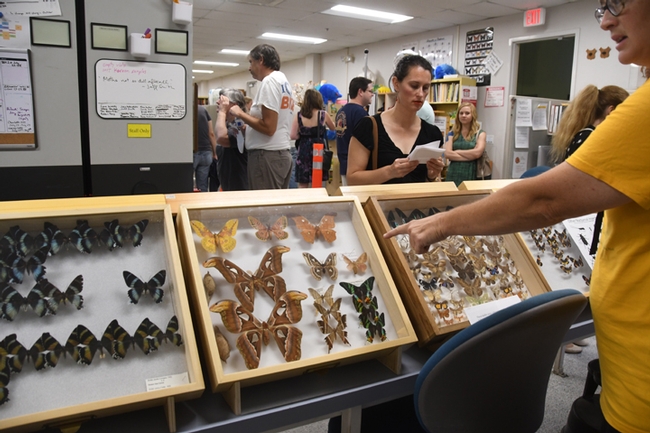
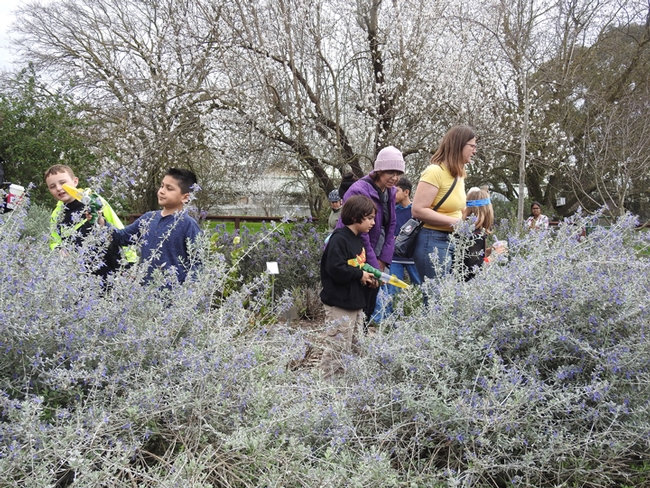
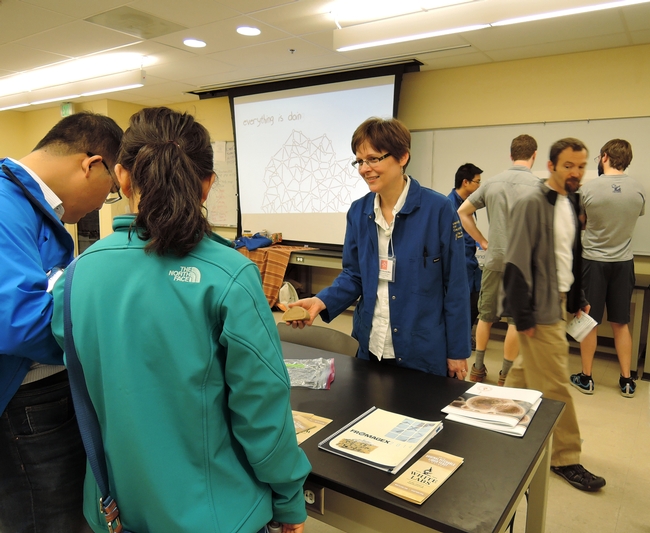

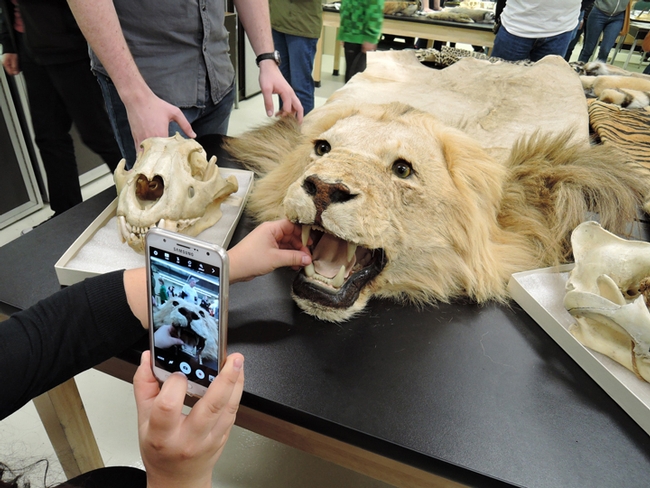
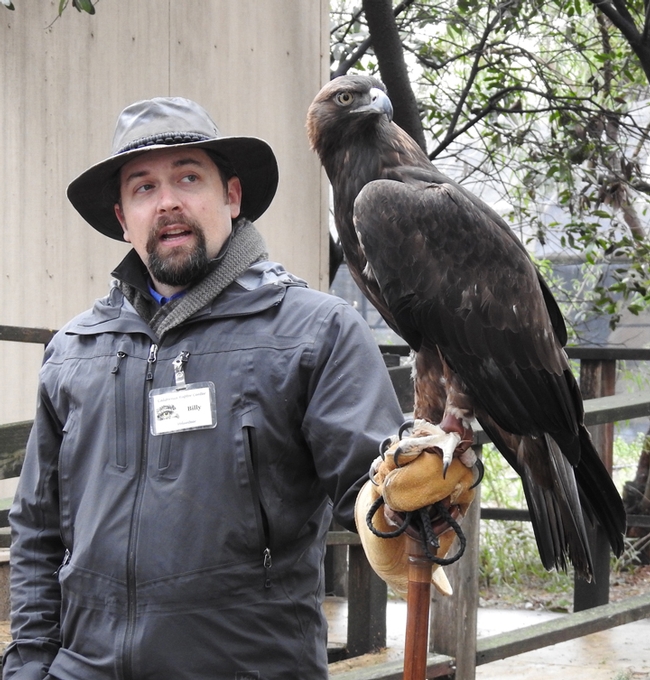
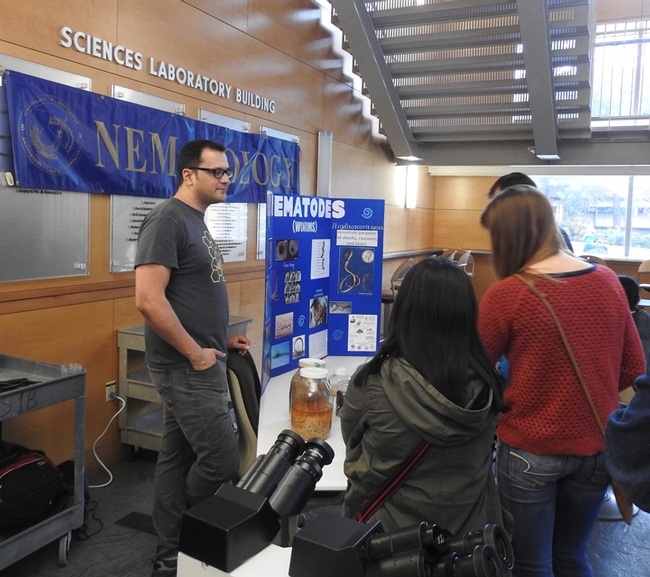
- Author: Kathy Keatley Garvey

They should limit their hobby to two colonies, says Gary, 85, whose expertise in beekeeping, including professor, scientist, author and professional bee wrangler, spans seven decades.
“Increasing populations of bees can easily ‘overgraze' the resources,” Gary explains. “Excessive competition for limited nectar and pollen sources also threatens hundreds of native bee species, such as bumble bees, that have similar dietary requirements.”
In his newly published second edition of his book, Honey Bee Hobbyist: The Care and Keeping of Bees (Fox Chapel Publishing, East Petersburg, Pa.), he includes a chapter on “Urban Entomology” that “treads on sacred beekeeping ground by proposing a radical change to beekeeping in urban environments.”
But it's time “to recognize the realities of the urban environment and make appropriate changes in beekeeping practices,” he declares.
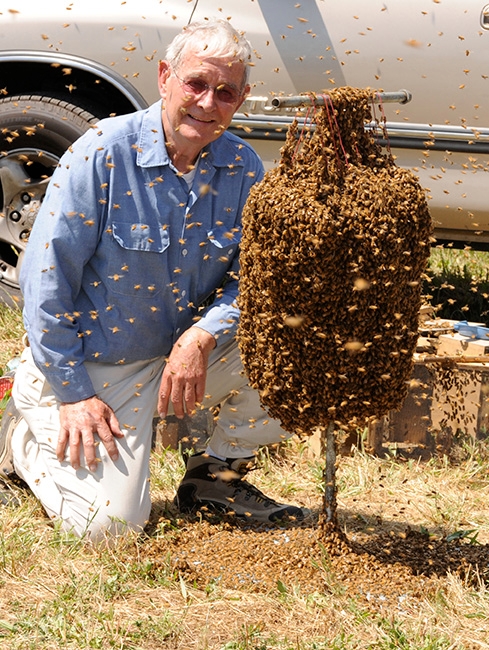
“The yield of honey per colony is declining significantly in urban environments,” he says. “These declines leave no doubt that overpopulation of bees in urban settings is the primary cause. Few beekeepers are aware that each bee colony consumes at least 100 pounds of honey annually, made from approximately 200 pounds of nectar! When nectar is abundant and there is good weather for foraging, a typical honey colony has the potential to produce more than 100 pounds of harvestable honey per year.”
“This is far more than typical hobby beekeepers are harvesting these days,” Gary relates. “It should be obvious that hobby beekeepers are keeping too many colonies in the typical urban environment.”
“Hobby beekeepers typically start out with one or two hives, but that often leads to several more due to their enthusiasm for keeping bees and harvesting more honey and equating the number of hives with elevating their status as beekeepers.”
In his book, he shares his beekeeping knowledge, dispels many beekeeping myths and provides science-based information. He covers such subjects as “To Beekeep or Not to Beekeep,” “The Bees' Home,” “Reproduction,” “Colony Defense and Sting Prevention” and activities inside and outside the hive.
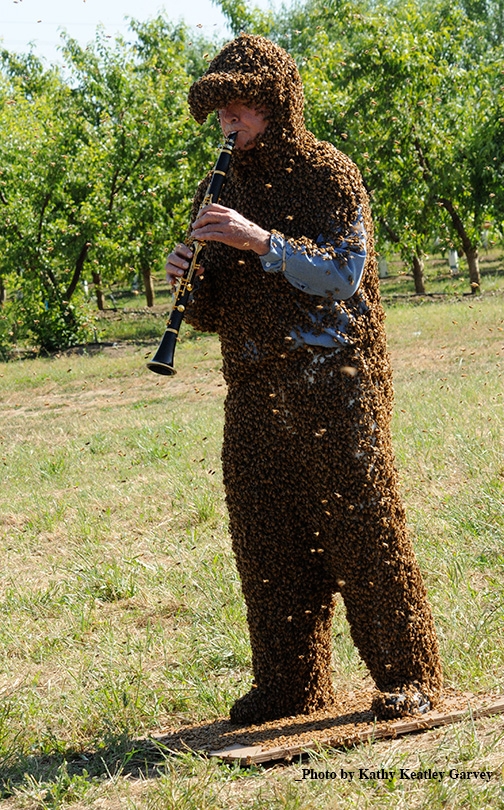
Gary, who holds a doctorate in entomology from Cornell University, joined the UC Davis entomology faculty in 1962, retiring in 1994 after a 32-year academic career. He has authored more than 100 publications, including scientific papers, book chapters and popular articles in beekeeping trade journals.
A 70-year beekeeper--one of the longest in the nation--Gary began keeping bees at age 15 in Florida. His career includes hobby beekeeper, commercial beekeeper, deputy apiary inspector in New York, honey bee research scientist, entomology professor, author, bee wrangler and Guinness World record holder.
During his professional bee wrangler career spanning four decades, “The Bee Man” served as a consultant and bee stunt coordinator for 17 movies, 70 TV shows and six TV commercials. Among his credits: “Fried Green Tomatoes” and appearances with Johnny Carson and Jay Leno on Tonight Shows.
He launched the Thriller Bee Shows, performing more than 100 times in three western states, with venues that included the California State Fair. He drew widespread acclaim for wearing a head-to-toe suit of clustered bees while "Buzzin' with His Bee-Flat Clarinet."
Gary once trained bees to fly into his mouth to collect food from a small sponge saturated with artificial nectar. His holds the Guinness World record (109 bees inside his closed mouth for 10 seconds) for the stunt. He's also the person behind the "bee suit" record in the Guinness World Records; Gary clustered more than 87 pounds of bees on a friend.
Today, as a musician, he plays the clarinet, alto sax, tenor sax, and flute with several groups, and is updating his website, http://www.normangary.com.
No more “Buzzin' with His Bee-Flat Clarinet,” though.
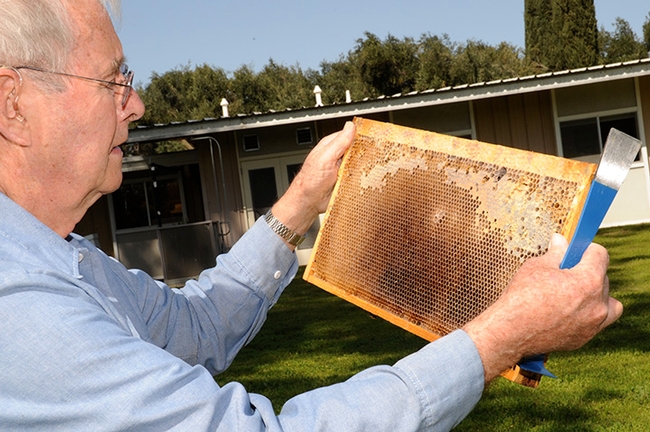
- Author: Kathy Keatley Garvey
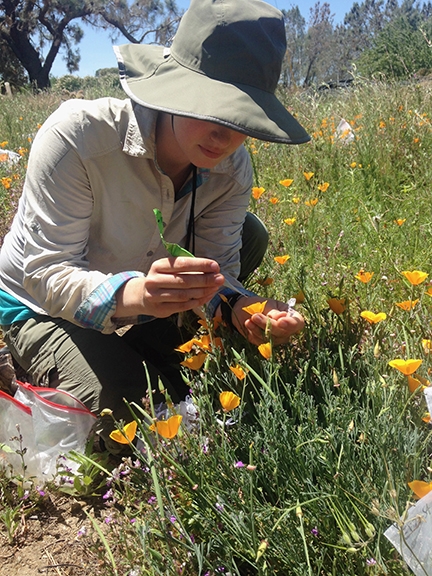
Page, a pollination ecologist, was one of 69 awardees selected from more than 3600 applicants. Her fellowship is funded by the Department of Defense.
“The fellowship is well deserved,” said Williams, her major professor and a pollination ecologist and a UC Davis Chancellor's Fellow. “Maureen is a talented researcher, who shows a real passion for her research that is combined with a highly analytical meticulous approach.”
Of her project, Williams said: “Her work melds careful field sampling with advanced analysis, including computational optimization modeling. It will move existing research to a new level by exploring the nutritional basis of competitive interactions among pollinators. The project builds from a solid foundation but his highly innovative. Its results should be of tremendous value to the scientific community, but are also highly relevant for decision making to promote sustainable food systems for California and beyond.”
Page received her bachelor's degree in biology, cum laude, from Scripps College, Claremont, Calif., in 2016, and then enrolled in the UC Davis entomology graduate program, with a career goal of becoming a professor and principal investigator.
“I became interested in UC Davis because I was interested in working in Neal's lab,” she related. “After my sophomore year of college, I participated in National Science Foundation's Research Experiences for Undergraduates (NSF REU) with the Chicago Botanic Gardens. One of the professors I was working with, Jennifer Ison, told me that my research interests aligned well with the work coming out of Neal's lab and I quickly realized she was right.”
“I even bookmarked the Williams lab webpage so I could check for recent papers!” Page said. “Neal is an even better advisor than I could have hoped for and I feel very grateful to be a part of UC Davis Department of Entomology and Nematology.”
Her dissertation research focuses on using plant-pollinator interaction networks to (1) assess the impact of honey bee introductions on native plant pollination and (2) optimize wildflower plantings to simultaneously support honey bee health and diverse native bee communities.
“I've always loved flowers and I think my love of bees grew out of my academic interest in pollination ecology and a desire to apply my talents towards research that would benefit farmers and pollinator conservation efforts,” said Page, a native of San Francisco but who grew up in Ashland, Ore.
As a volunteer researcher for Southern Oregon University, she worked on a watershed project in the Klamath-Siskiyou Wildlands Center, and was named the City of Ashland's Conservationist of the Year in April 2012. The city honored her at its Earth Day celebration.
Keenly interested in bee research, Page received a 2013 Scripps Environmental Research Grant to establish a solitary bee monitoring program at the Bernard Field Station in Claremont. She created a reference collection and species list of bee diversity at the field station, gaining experience collecting, pinning and identifying bee specimens. She presented her findings at the Scripps Undergraduate Research Symposium. Page later worked on a project categorizing pollen deposition by the yellow-faced bumble bee, Bombus vosnesenkii to California figwort, Scrophularia california.
What fascinates her about bees? “Tough question!” said Page, who is the first entomologist in her family. “Bees are so very interesting for so many different reasons! I'm particularly fascinated by the relationship between bees and flowers--with bees acting as pollinators and flowers offering bees important pollen and nectar resources. I think the biggest misconception is that all bees are honey bees. In fact, there are more than 20,000 species in the world, only 7 of which are considered honey bees!”
An average day?
“My field season has started, so on an ‘average day' I'm at one of my lab's wildflower plantings by 7 a.m. and driving home with coolers of bees and flowers around 7 p.m.,” Page said. “The most fun part of my fieldwork is using something called a ‘mobile bouquet' to measure single-visit pollen deposition by different pollinator taxa to different plant taxa.”
Page was awarded a grant from the Davis Botanical Society earlier this year, and won second place in the graduate students' poster competition at the 2018 UC Davis Bee Symposium for her poster, “Impacts of Honey Abundance on the Pollination of Eschscholzia californica. Last year she received a Northern California Botanists' Grant and a Davis Botanical Society Grant.
Eager to reach youth about the importance of pollinators, Page began volunteering in 2016 for the Center for Land-Based Learning, mentoring students from Sacramento High School, and engaging them in hands-on conservation science at Say Hay Farms, a 20-acre family farm in Yolo County. She has taught students at her Davis area field site about the benefits of providing wildflower habitat for pollinators.
The UC Davis doctoral student has also presented lectures at the Hoes' Down Harvest Festival, Yolo County, on “Pollinators on the Farm” and led a kids' bug hunt. She presented an invited lecture on “Beneficial Insects in Home Gardens” to the El Dorado Master Gardeners, part of the UC Cooperative Extension program, and volunteered at their other activities.
Page serves as secretary of the UC Davis Entomology Graduate Student Association. In her leisure time, she enjoys “baking, rock climbing, learning new things, and sketching--mostly-flowers, bees, and sometimes butterflies.”
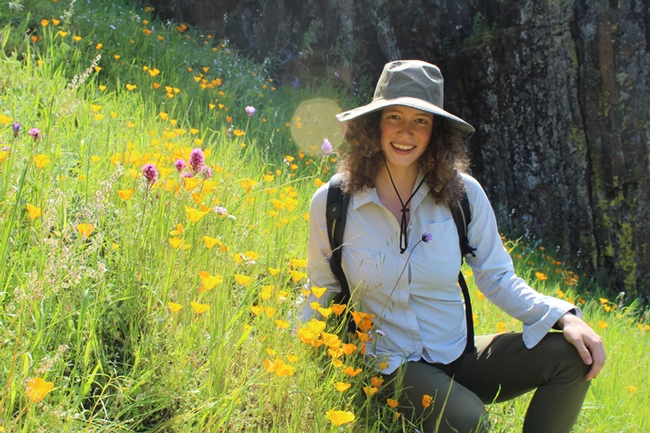
- Author: Kathy Keatley Garvey
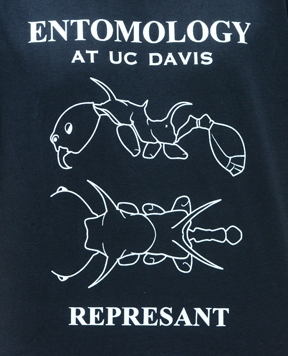
Doctoral candidate and ant specialist Brendon Boudinot of the Phil Ward lab won the EGSA contest with his REPRESANT design, with illustrations by colleague Eli Sarnat, an alumnus of the Ward lab.
Doctoral candidate and nematologist Corwin Parker of the Steve Nadler lab won the Picnic Day design with his illustration of a bee barbecuing.
And an ant design for a onesie, “My Sister Loves Me,” by doctoral student and ant specialist Jill Oberski of the Ward lab rounds out the winners' circle.
Boudinot, a fourth-year doctoral student and president of EGSA, said the ant featured on his design “is a minor worker of the Drogon ant and described recently by our post-doc Eli Sarnat." Sarnat, who received his doctorate in entomology from UC Davis in 2009, is now a post-doctorate researcher in the Okinawa Instituite of Science and Technology in the Economo lab. The ant in Boudinot's design is based on Sarnat's work, published in AntWiki and in The Guardian.
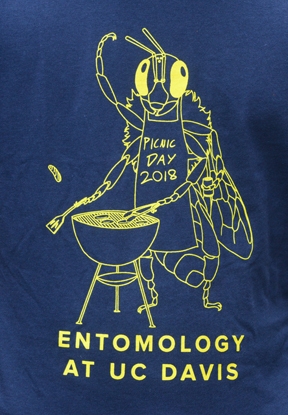

Oberski's adult ant is “loosely based on Ochetellus, a mostly-Australian genus.” After admiring an image taken by Alex Wild, also a Phil Ward lab alumnus (doctorate in entomology in 2005) and “I went from there.” Wild, a renowned macro photographer, is the curator of Entomology at the University of Texas/Austin.
The winning T-shirts and other previous winners can be ordered online at https://mkt.com/UCDavisEntGrad/ and also will be available at Briggs Hall on April 21 at the annual UC Davis Picnic Day and future Picnic Days. Doctoral student and medical entomologist Olivia Winokur of the Chris Barker lab, serves as treasurer of EGSA and t-shirt sales coordinator. She may be reached for more information at ocwinokur@ucdavis.edu.
The EGSA is comprised of UC Davis graduate students who study insect systems. Its objectives are to connect students from across disciplines, inform students of and provide opportunities for academic success, and to serve as a bridge between the students and administration. The officers, in addition to Brendon Boudinot, are Emily Bick of the Christian Nansen lab, vice president; Maureen Page of the Neal Williams lab, secretary; Olivia Winokur of the Chris Barker lab, treasurer; and two Graduate Student Association representatives, Charlotte Herbert of the Bohart Museum of Entomology and Nick Booster of the Jay Rosenheim lab.
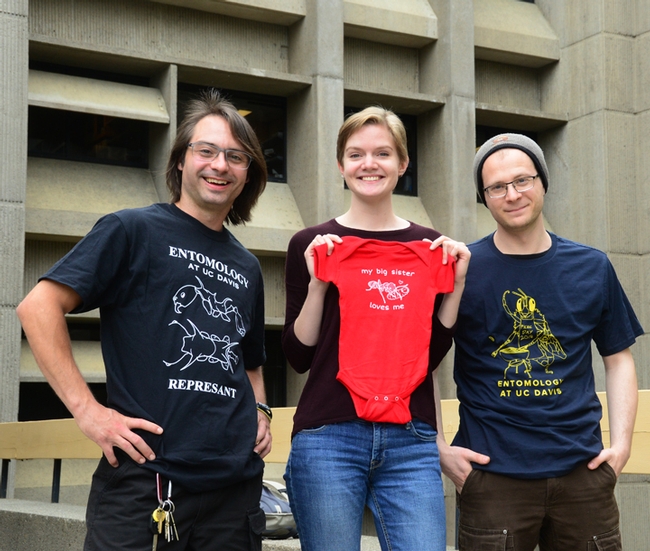
- Author: Kathy Keatley Garvey
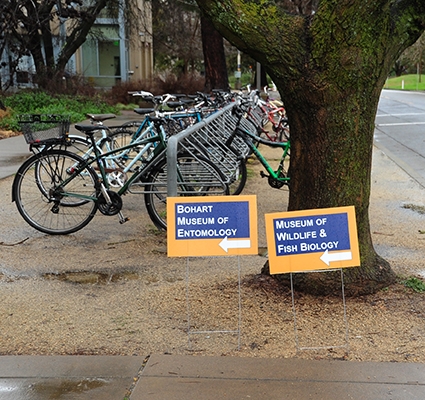
DAVIS--Crowds will "explore the diversity of life" at 13 museums or collections during the seventh annual UC Davis Biodiversity Museum Day on Saturday, Feb. 17. The event, set from 9 a.m. to 4 p.m. is free and open to the public.
Displays will range from ancient dinosaur bones to live praying mantises, from hawks to honey bees and from California condor specimens to carnivorous plants. Last year's Biodiversity Museum Day drew more than 4000 visitors to campus.
This is a family friendly, science-based event, said Biodiversity Museum Day chair Tabatha Yang, education and outreach coordinator for the Bohart Museum of Entomology. All 13 museums or collections are within walking distance on campus except for the Häagen-Dazs Honey Bee Haven on Bee Biology Road and the Raptor Center on Old Davis Road. Openings vary from 9 a.m. to 1 p.m. and from noon to 4 p.m.
The following will be open from 9 a.m. to 1 p.m.:
- Arboretum and Public Garden, Good Life Garden, next to the Robert Mondavi Wine and Food Science Institute, 392 Old Davis Road, on campus
- Bohart Museum of Entomology, Room 1124 of the Academic Surge Building, Crocker Lane
- California Raptor Center, 340 Equine Lane, off Old Davis Road
- Museum of Wildlife and Fish Biology, Room 1394, Academic Surge Building, Crocker Lane
- Paleontology Collection, Earth and Physical Sciences Building, 434 LaRue Road
- Phaff Yeast Culture Collection, Robert Mondavi Institute of Wine and Food Science, 392 Old Davis Road, on campus
- Viticulture and Enology Culture Collection, Robert Mondavi Institute of Wine and Food Science, 392 Old Davis Road, on campus
The following will be open from noon to 4 p.m.:
- Anthropology Museum, 328 Young Hall and grounds
- Design Museum, 124 Cruess Hall, off California Avenue
- Botanical Conservatory, Greenhouses along Kleiber Hall Drive
- Center for Plant Diversity, Sciences Laboratory Building, off Kleiber Hall Drive
- Häagen-Dazs Honey Bee Haven, Bee Biology Road, off Hopkins Road (take West Hutchison Drive to Hopkins)
- Nematode Collection, Sciences Laboratory Building, off Kleiber Hall Drive
All participating museums and collections have active education and outreach programs, Yang said, but the collections are not always accessible to the public. In the event of rain, alternative locations are planned for the outdoor sites. Maps, signs and guides will be available at all the collections, online, and on social media, including Facebook and Twitter, @BioDivDay.
Capsule information about each museum or collection:
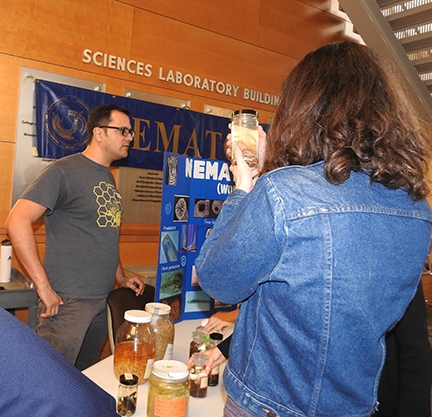
The Arboretum and Public Garden display will be from 9 a.m. to 1 p.m. at the Good Life Garden, next to the Robert Mondavi Wine and Food Science Institute, 392 Old Davis Road, on campus. It will join two other collections: Phaff Yeast and Viticulture and Enology. The Arboretum activities will be interactive; Learning-by-Leading Students are creating the content that will be featured on the day of Biodiversity Day. Coordinator: Melissa Cruz, outreach and leadership program coordinator.
Bohart Museum of Entomology
The Bohart Museum of Entomology will be open from 9 a.m. to noon in Room 1124 of the Academic Surge Building on Crocker Lane, off LaRue Road. The Bohart is the home of a global collection of nearly 8 million insect specimens. Highlights will include the 500,000-specimen butterfly/moth collection, curated by entomologist Jeff Smith; display of praying mantises, including orchid mantises, by UC Davis entomology student Lohit Garikipati; and a Belize insect collection display by Smith and fellow Bohart Museum associates Fran Keller and Dave Wyatt from their latest expedition. "You'll be able to see the tremendous diversity of butterflies, moths and mantids, and talk to the scientists who have just returned from there," said Tabatha Yang, education and outreach coordinator. "There will be orchids and orchid bees connecting the Bohart Museum's work with plant biology and science."
California Raptor Center
The California Raptor Center on 1340 Equine Lane, Davis, just off Old Davis Road, will be open from 9 a.m. to 1 p.m. A living collection of non-releasable raptors will be on exhibit. The center's educational ambassador birds will be out "on the fist" in the fenced yard by the museum, so visitors can get a close look at wild raptors while talking to the volunteers and learning about the magnificent birds of prey that live in this area, said Julie Cotton, volunteer and outreach coordinator. The on-site museum, recently renovated, features redesigned exhibits and a new touch-screen display. Coordinator: Julie Cotton, volunteer and outreach coordinator.
Museum of Wildlife and Fish Biology
The Museum of Wildlife and Fish Biology, in Room 1394 of the Academic Surge Building, Crocker Lane (off LaRue Road) will be open from 9 a.m. to 1 p.m. Visitors can view the bird and mammal museum specimen taxidermy demonstrations; explore the research collections with museum docents; see the newly acquired California condors on display, and see other specimens on display, including Papua New Guinea birds and mammals, reptiles and amphibians, primates and marine fishes. Note that strollers are not allowed in classroom or museum, they can be parked them under adjacent stairwell. Visitors are also asked to wash their hands before entering museum. Coordinator: Andrew Engilis Jr., director.
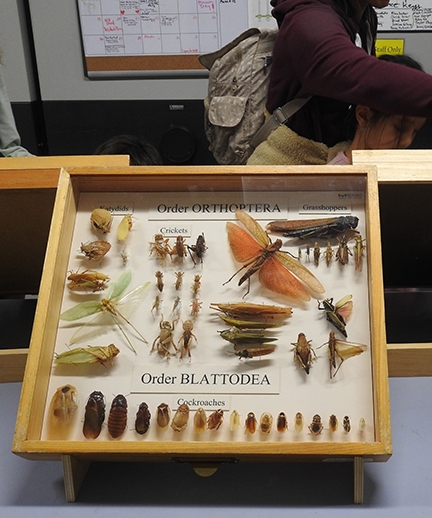
The Paleobiology Collection will be open from 9 a.m. to 1 p.m. in the Earth and Physical Sciences Building, 434 LaRue Road. Visitors can view fossil specimens dating from as old as 550 million years ago to more recent animal skeletons. Paleontology graduate students in invertebrate and vertebrate paleontology will answer questions and provide interesting factoids. Coordinator: Mark Deblois, Department of Earth and Planetary Sciences.
Phaff Yeast Culture Collection and Viticulture and Enology Culture Collection
These collections will be open from 9 a.m. to 1 p.m. in the Robert Mondavi Institute for Wine and Food Science, 392 Old Davis Road, on campus. Visitors can learn about the importance of microbes in research, biotechnology, and food and beverages, and about the proud history of two of the world's prominent microbe collections. The Phaff Yeast Culture Collection is part of the Department of Food Science and Technology department, and the Viticulture and Enology Culture Collection is part of the Department of Viticulture and Enology. Visitors can see and smell dozens of yeast species, learn how yeasts and bacteria are important for making fermented foods and beverages (even clothes can be made from microbes), taste vegemite, marmite and kombucha tea; learn about cutting edge research using these microbe collections; and tour the UC Davis teaching winery and brewery.
The microbe collection activities will be in the Robert Mondavi Institute Brewery, Winery and Food Processing building, which is in the southwest area of the complex of orange buildings at Old Davis Road and Hilgard Lane. Coordinators: Kyria Boundy-Mills, Phaff collection curator and specialist, Food Science and Technology, and Lucy Joseph, Viticulture and Enology collection curator and senior museum scientist.
Anthropology Museum
The Department of Anthropology Museum in 328 Young Hall will be open from noon to 4 p.m. The Anthropology Museum curates collections of archaeological, ethnographic, biological and archival materials. The theme is "Year of the Dog" and there will be a scavenger hunt for kids to find all the hidden dogs in the exhibits, and people can test their skills as an ancient hunter and toss an atlatl dart or learn to make a tool from volcanic stone, says zooarchaeologist Christyann Darwent. The Anthropology Museum curates collections of archaeological, ethnographic, biological and archival materials. The museum maintains a teaching collection that includes casts and reproductions of artifacts from a variety of prehistoric human groups. Coordinator: Christyann Darwent, associate professor.
Design Museum
The Design Museum will be open from noon to 4 p.m. in Room 124 of Cruess Hall. Professor Timothy McNeil and curator Adrienne McGraw will staff the exhibit, It's Bugged: Insects' Role in Design, which explores the connections between people and insects. This is a special opening just for Biodiversity Museum Day. (The exhibit opened Jan. 8 and continues through April 22; regular hours are weekdays from noon to 4 p.m. and Sundays from 2 to 4 p.m.) "It's Bugged" includes art from hornet nest paper; beetle-gallery sculptures, and insect-themed clothing from the Department of Design faculty and graduate students; and insect specimens from the Bohart Museum of Entomology and insect photos from UC Davis alumnus Alex Wild, curator of entomology at the University of Texas, Austin. Coordinators: Timothy McNeil, professor, and Adrienne McGraw, exhibition curator.
The Botanical Conservatory
The Botanical Conservatory, greenhouses on Kleiber Hall Drive, will be open from noon to 4 p.m. Visitors can expect a multi-sensory experience of a plethora of plants primarily from the tropical and subtropical biomes. Featured plants and displays include the always popular carnivorous plants, fruiting specimens of Chocolate (Theobroma) and Coffee (Coffea), various Amorphophallus species at various stages of leaf and possibly flowering individuals, an assortment of cacti, succulents and other desert dwellers, and finally an assortment of winter blooming South African Bulbs to further entice the senses. Coordinator: Ernesto Sandoval, collections manager.
Center for Plant Diversity Herbarium
The Center for Plant Diversity Herbarium, open from noon to 4 p.m. in Room 1026 of the Sciences Laboratory Building, central campus (off Kleiber Hall Drive), will exhibit Hmong medicinal and culinary herbs. Viewers can view and identify plants under the microscope and watch plant pressing and mounting demonstrations. A kids' area activity will include pressed plants/glue/paper. Coordinator: Ellen Dean, curator.
Häagen-Dazs Honey Bee Haven
Häagen-Dazs Honey Bee Haven, a half-acre bee demonstration garden next to the Harry H. Laidlaw Jr. Honey Bee Research Facility, Bee Biology Road, will be open from noon to 4 p.m. Activities include catch-and-release bee viewing and making "Feed the Bees" seed cookies. The haven was installed in the fall of 2009. A six-foot-long bee sculpture, Miss Beehaven, by artist Donna Billick, co-founder and co-director of the UC Davis Art/Science Fusion Program, anchors the haven. Other art, coordinated by entomology professor Diana Ullman, co-founder and director of the Art/Science Fusion Program, and Billick, also graces the haven. Guests will see bee condos occupied by leafcutter bees and mason bees. Robbin Thorp, distinguished emeritus professor of entomology, has recorded more than 80 different species of bees in the garden. Coordinator: Christine Casey, academic program management officer.
Nematode Collection
The nematode collection will open from noon to 4 p.m. in the Science Laboratory Building, central campus (off Kleiber Hall Drive). Visitors can expect to see live and preserved nematode specimens. Highlights include the huge jars of whale intestinal worms. Nematodes, also called worms, are elongated cylindrical worms parasitic in animals or plants or free-living in soil or water. They exist in almost every known environment. The many different species eat everything from bacteria and fungi to plant and animal tissue. Coordinator: Corwin Parker, nematology doctoral student.
For further information about the Biodiversity Day, access the UC Davis Biodiversity Museum Day website.
